2.11 The Bridge Between Blockchains: Polkadot
Free Airdrop Season 7 is LIVE! Answer fun questions or do simple tasks to earn rewards from the $30K BitDegree prize pool. Participate Now ! 🔥
In this section, I’ll tell you about Polkadot. Specifically, I’ll tell you what is Polkadot in crypto, how it works, and what it’s used for, in the first place.
Imagine that you have decided to visit a friend who lives in another town. He’s organizing a small get-together, and there will be people who will come from multiple other towns and cities. Driving there, however, all of you notice that there’s a river that needs to be crossed, in order to get to the friend’s house.
Even though you and the other people are coming from different towns, each and every one of you needs to cross that river in order to be able to meet each other. Thankfully, though, there are bridges that allow you to cross, no sweat. In the crypto world, these bridges would be called Polkadot.
Now, let’s get into more detail!

Video Explainer
Video Explainer: The Bridge Between Blockchains: Polkadot
Reading is not your thing? Watch the "The Bridge Between Blockchains: Polkadot" video explainer
What is Polkadot in Crypto? (DOT Animated Explainer)
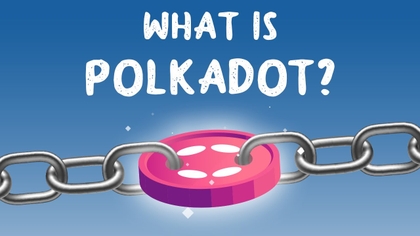

What is Polkadot?
I’ll get back to the example I gave at the beginning of the section shortly. Before I do that, though, let’s first explore WHAT Polkadot is.
Polkadot is a cryptocurrency project. It’s a dedicated blockchain network (meaning, it has its own blockchain), with a native coin called DOT. At the time I'm writing this section, Polkadot is the 11th largest cryptocurrency, by market capitalization.
Polkadot has a very interesting history. It’s a crypto project that sometimes gets mixed up with Ethereum, with people thinking that Polkadot actually uses Ethereum in its operations. Well, it does not - however, the two crypto projects are actually related, in a very specific way.
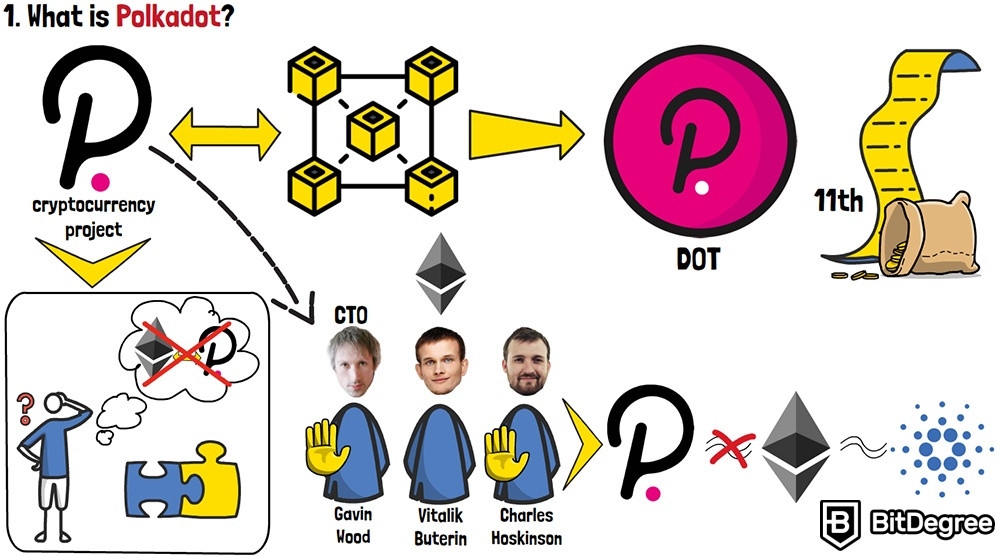
Polkadot was created by a man named Gavin Wood. If this name sounds familiar to you, it’s because Wood was the CTO of Ethereum, and one of the original founders of the cryptocurrency. After all co-founders of ETH left the project (except for Vitalik Buterin), some of them went on to create cryptos of their own - Charles Hoskinson creating Cardano is one of the more well-known examples.
Gavin Wood, on the other hand, created Polkadot. And, while Cardano is somewhat similar to Ethereum, as far as use cases go, Polkadot is very different.
How Does Polkadot Work?
In order to understand how Polkadot works, you can simply think about the name of this blockchain network - it has a hint for you to figure out!
In the real world, polka dots are a pattern of dots on a surface, all placed close to each other, with an equal amount of distance between them. Imagine these dots as different blockchains - Ethereum, Cardano, Bitcoin, and so on.
Each of these blockchains is unique, and possesses features and functionalities that are only available on them. However, what happens if two different and unique blockchains would want to communicate with each other? Well, to put it simply, they couldn’t - both blockchain networks have different cryptocurrencies associated with them, and are coded differently, too. In order for them to communicate, they need some sort of a bridge.
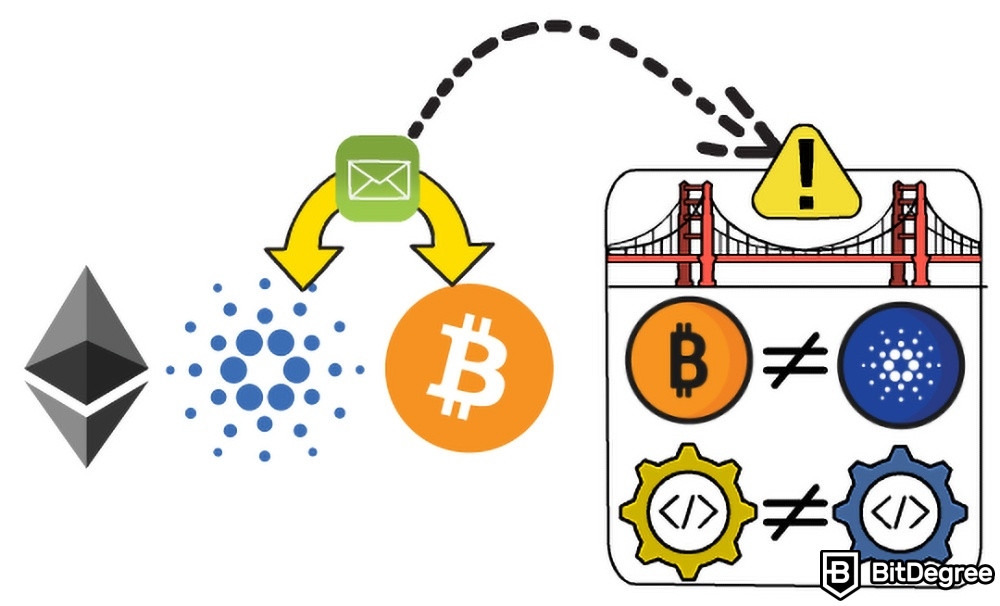
This is where the example I gave at the beginning of the section comes in, too. If you want to visit your friend, but need to pass a river to do so, you’ll need a bridge. This bridge allows you to get together with your friend on the other side of the river, to communicate and exchange information.
Well, in the cryptocurrency world, Polkadot acts as that bridge.
To be more specific, Polkadot allows two different blockchains to communicate with one another. It acts as a bridge between two networks that would otherwise have no ability to communicate!
So think about it this way - imagine that each blockchain is a drawing tool. Pencils, markers, crayons, and so on. In order to use all of these tools to draw a picture, you need a sheet of paper. In this example, Polkadot would be that sheet of paper, allowing you to use the different drawing tools, and for the tools to interact with each other, forming a picture.
In the cryptocurrency world, this is called “interoperability”. It sounds like a fancy term, but in actuality, it simply means “connection”, or “information sharing.“
Interoperability is something that blockchain networks have struggled with, since the early days. While blockchains could be used on their own, there was no reliable way to connect them with one another, in order to create advanced-level projects in the crypto space. Polkadot aims to solve this interoperability problem by positioning itself as a “Layer 0” network.
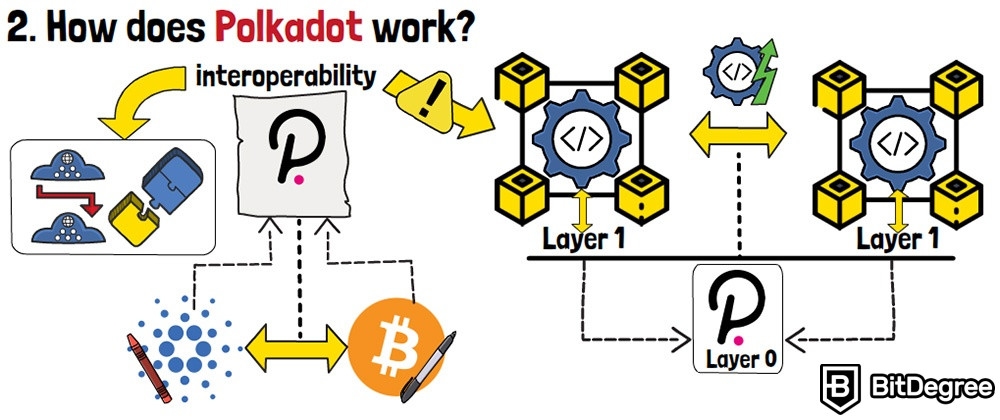
Not to get too much into the difficult technicalities, most blockchains out there are considered to be “Layer 1”. So, the very first layer of the blockchain is the blockchain network itself - that makes sense. However, in Polkadot’s case, it positions itself as a “Layer 0” project - meaning, it lies beneath the other blockchains. Just like that sheet of paper that I’ve mentioned earlier - you can use the drawing tools on it, and your picture will sit on top of the paper sheet!
Relay Chain and Parachains
So, now you have a better idea of what Polkadot is, and how it works, on the surface level. Moving on with the section, let’s now take a closer look at the mechanics behind Polkadot, and how it’s able to accomplish this “Layer 0” functionality. Don’t worry, because I will keep everything as simple as possible!
On the surface level, Polkadot looks like a simple blockchain, just like any other. Essentially, it’s a Proof-of-Stake network. In the most basic sense, it means that it uses staking mechanics, and allows DOT coin holders to earn passive coins by staking some of their own.
The two things that make Polkadot unique, and stand out from other blockchains, however, are the relay chain, and the parachains. Let’s break them down.

The relay chain is the center of the Polkadot network. It’s like the largest shopping mall, in the very center of a city. This is the most important part of the network - it allows Polkadot to work the way that it does!
Parachains are all of the different blockchain networks connecting to the relay chain. It’s like the different shops that you’ll find in that shopping mall I’ve mentioned just now. All of these shops sell their own specific products but, by the end of the day, they are all reachable in that same shopping mall. This means that you don’t need to drive to the other side of the city to visit some remote and isolated shop to get what you want.
All of these different parachains do their own thing, and communicate with their own projects and networks. However, every once in a while, they all have to sync up with the relay chain.
It’s like you working in a job, together with other employees! All of you have your own responsibilities, and tasks that need to be completed. However, every so often, there are meetings being held, so as to establish a clear direction of where the company is going, and to update each other on your work progress. This is a very similar example to that which is given by Gavin Wood, the founder of Polkadot, when he’s explaining parachain functionality.
Now, remember when I said that Polkadot is a Proof-of-Stake network? Well, this is important because, in order to become an active member of the network, and validate the transactions happening on it, you will need to stake a lot of DOT coins.
What does “a lot” mean? Well, this number is going to vary quite a bit, depending on the time that you’re reading this section. However, it’s a number that helps discourage foul play on the blockchain network, and ensures optimal security measures for anyone using it.
This is the other thing, too - Polkadot is often seen as a very reliable and secure network. It allows developers to create projects using parachains, which both boosts and innovates the ecosystem of Polkadot, as well as makes it easier to create new platforms and networks, too.
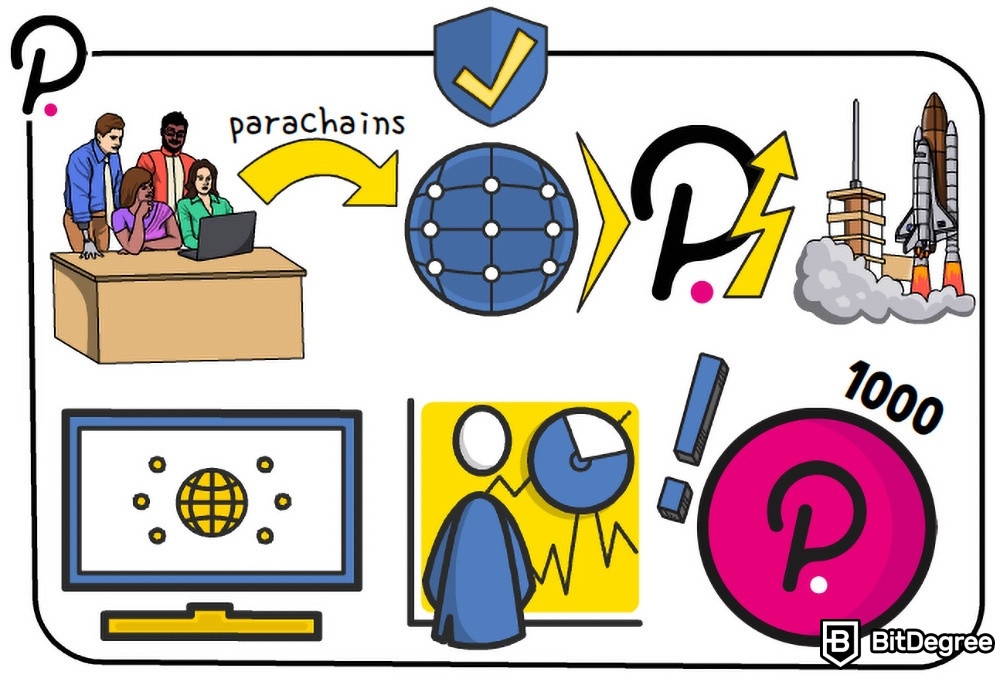
One of the things that help Polkadot remain secure and reliable are validator nodes. Since there’s a pretty high benchmark that you need to meet to become a validator on the network (or, in other words, you need to have a LOT of DOT coins), there’s a financial responsibility to take network validation seriously.
Following that, another thing that helps keep the Polkadot network secure and running smoothly is the treasury. The absolute majority of public blockchains have their own treasuries - when you trade coins, a certain part of the trading fee that you pay goes to those treasuries.
The funds of the treasury can then be used to experiment with new updates, make suggestions, and build up the community, as a whole. Speaking of experimentation, though, when figuring out how does Polkadot work, you will also come across the term “Kusama”.
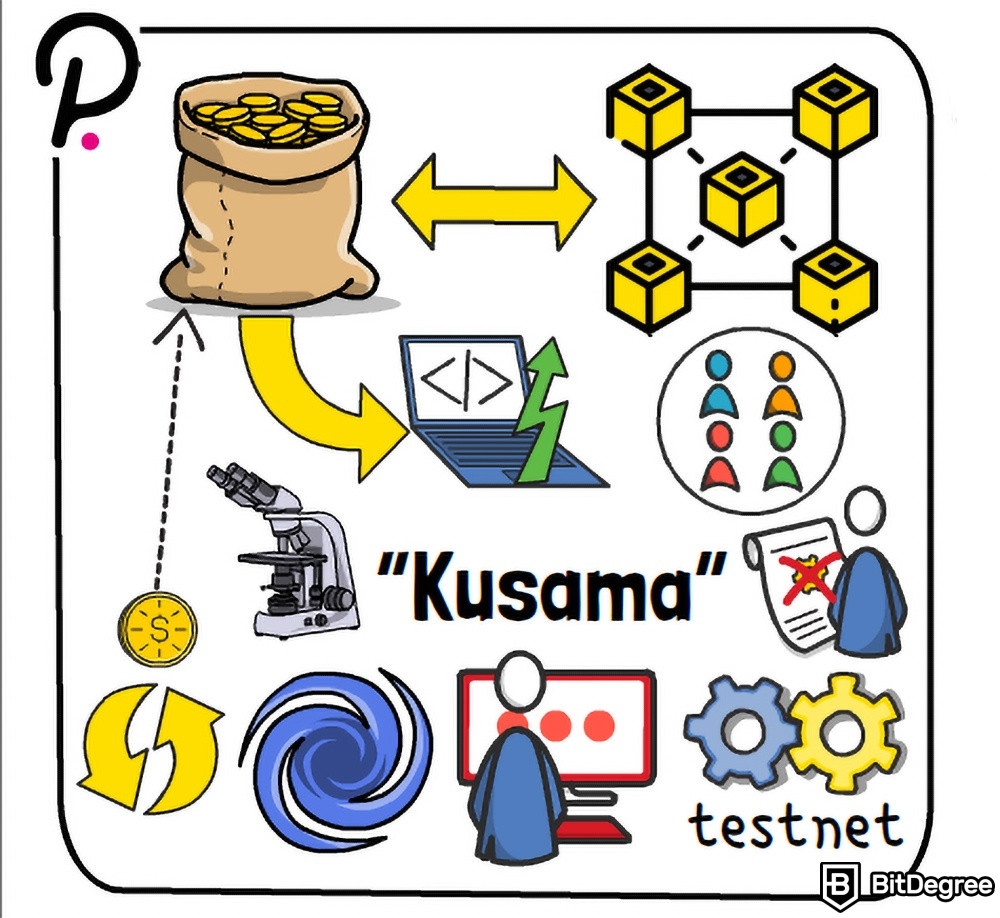
Not to go into too much technical detail, Kusama is a separate space on the Polkadot blockchain where developers are able to experiment with their projects, and see how they would work in the real world. While not being entirely correct, for simplicity’s sake, you can view it as a sort of a testnet.
Overall, Polkadot is definitely one of the more-interesting blockchain projects that are currently still standing strong. It’s being developed constantly, and offers a very unique approach to blockchain cross-chain communication.










